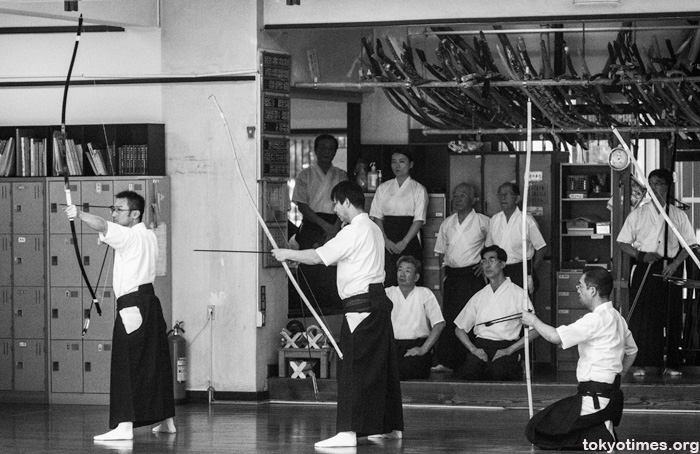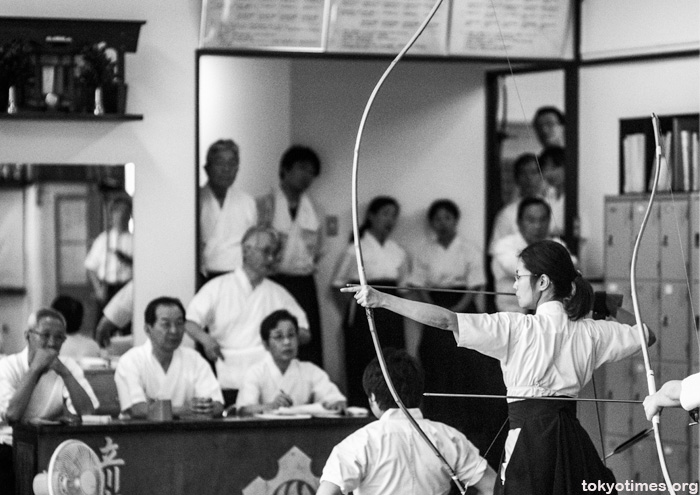Many traditional Japanese pastimes are extremely regimented, leaving little room for spontaneity, and Kyudo, Japanese archery, is no different. With the emphasis very much on ritual and technique, archers must always complete the hassetsu (eight stages of shooting) — a set of steps so painstakingly followed that the eventual release of the arrow appears merely a part of the process, rather than the main purpose. An idea that the martial art’s association with zen Buddhism, and an emphasis on meditation and self-improvement, would seem to support.
In competitions, however, it is actually hitting the target that ultimately counts, although along with the aforementioned hassetsu, archers must also perform an intricate series of actions as they enter the dojo. Plus on top of that they are also required to kneel after each shot before slowly rising again when it’s their turn.

An effort that, along with the deadly seriousness of everybody involved, and the complete and utter silence, looked more like an exercise in discomfort, than development.
Yet despite this, the very obvious dedication on display, and the almost reverential atmosphere in and around the dojo, made it absolutely fascinating to watch.

Mauro says
Interesting shots :). And the description sure is elucidating. May I ask why you chose to make them black&white?
Lee says
Thanks!
Yes, of course. When I was watching them it struck me how few hints of what year, or even decade we were in. Plus there was no technology present, and the equipment and clothes presumably haven’t changed much for an awfully long time. By opting for black & white, I was hoping to express this timelessness.
Ben says
I took kyudo for a short period before having to quit due to lack of time. It’s definitely a slow-paced, methodical art but not uncomfortable at all. Very relaxing actually since you get to pretty much go at your own pace. Not for the overly-caffeinated. 😉
Lee says
Cheers, that’s interesting to know. The relaxing nature certainly ties in with the meditation aspect, and possibly also accounts for its continuing popularity.
Len says
Nice photos. B&W was a good choice too. Not sure I could put up with all the rules, but it’s something I’d love to try once.
Lee says
Thanks! Yeah, me too. I had a brief try back in the UK a few years ago, but I’d be keen to have a go at this much more traditional version.
winnie says
Nice shots!
I think Kyudo is an interesting and beautiful art. Also, it also relating to science.
So cool and admirable! 🙂
Lee says
Thanks Winnie!
Yeah, it really was fascinating to watch. I can only imagine how much dedication is involved.
Calissaja says
I cycle past Kyoto University’s Kyudo training area every day and I always stop to watch. Totally fascinates me, but I think I might be a little too impatient to be any good.
Lee says
Yeah, I know what you mean. As interesting as it would be to try, I’m not sure it would suit me.
john says
Well I guess the outfits (and shirts) are all black and white.
Nice finger style in no. 2 :o)
Lee says
Yes, that struck me too. Didn’t notice the others doing it.
Don says
Extending the forefinger is an alternate way of holding the yumi (bow) Depending on the way your hand reacts to gripping you either extend to finger or relax it with a curvature. I used to extend but found that relaxing the finger also relaxed my grip and allowed for Yugaerei (turning of the bow )
Lee says
Cheers! Always good to have an explanation.